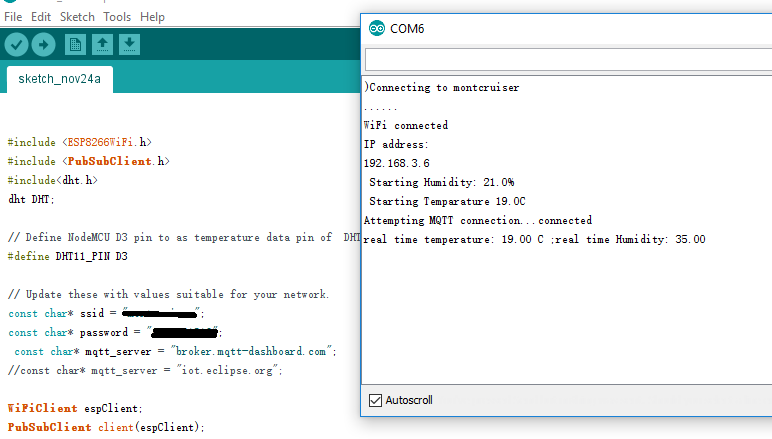
I initially connected GND, 3V3, TX and RX pins. Unfortunately my initial setup was a no go.
Coolterm cant see nodemcu serial#
This way I was able to interact with the board using a serial terminal software (Coolterm). My initial setup has been to use an Arduino UNO as a power supply for the 3.3V and another 3V USB to Serial adapter with one FTDI chip. Likely it seems that I/O are 5V-tolerant (or so they seem till now). Getting it to work has been a bit weird, as documentation was not very accurate and I was not paying much attention either.Ĭare has to be taken with power supply as the unit is to be powered at 3.3V and using 5V will probably kill it. The module offers, among other choices (I2C, SPI) a serial connection, running at 115200bps. My main interest was to use it with Arduino projects and, perhaps, as a way to use my 3D printers wirelessly.
Coolterm cant see nodemcu full#
It is a full SoC system which firmware can be updated. Sensor_porta.Some weeks ago it was mentioned in a new wifi module was available at a very tempting price (I paid $10 for two ESP8266 units shipped). Stdin:1: nesting of ] is deprecated near ‘]) Stdin:1: nesting of ] is deprecated near ‘])]]) The pin GPIO mappings have changed in 20141219 and later firmware. The door is open by default and when grounded the door is closed. Because I now have two references to the pin I added variable “doorpin”. I added gpio.mode(doorpin, gpio.INPUT, gpio.PULLUP) to the initialization steps in order to use the internal pull-up resistor. Thanks to everyone who has spend many hours developing and sharing. Plug the esp8266 to two 1.5V battery, remove FTDI and voilà! Automatic DOOR Sensor IOT!!! Reboot, and now each time will be automatically executing the code. To fix this, we have to modify the a script. Now input the IP of the ESP8266 as a URL on your favorite browser and you will have the result you’ve been looking for!Īn issue is that the script is stored on the circuit but it’s not loading automatically.

Writeline(])įile.writeline(])Īfter this, you will have written a a script that it’s gonna be available in the ESP8266 after each power off and on.Īnd if you don’t know the ip of ESP8266 type: So boot the terminal and type the following:

With this basic script we will be able to know the state of a push button from the web.įirstly we will build a LUA script named a ('SSID','password')Ĭongrats, now each time you power it on back again, it will remember last wifi connection wifi setup.įor this example we have used the following wiring:
Coolterm cant see nodemcu code#
Now with a burned LUA Firmware, we should reconfigure CoolTerm at 9600bps to be able to communicate with the board.Ĭonnect and type this basic code to check the wifi connectivity: So power it OFF, disconnect GPIO0 pin from ground… and voilà! you’ve got a ESP8266 with LUA Firmware

Otherwise it will be reboot in UPLOAD mode. To Burn a firmware: CH_PD pin must be always connected to HIGH and GPIO0 pin to GROUND (LOW)Įxecute ESP8266_flasher.exe and burn the bin inside LUA FirmwareĪfter burning it, GPIO0 pin should be disconnected from ground in order to reboot in normal mode. If you want to play with this firmware check this out: Once in, type AT+GMR, my firmware was based on 00160901Ĭongrats, you’ve got a working ESP8266 with a espressif firmware in it. If you face problems with this running on Windows check this link: Unbrick FTDI 232Rĭownload Coolterm (putty like app but much cooler)Ĭheck that your ESP8266 has some firmware through cooltermĮnter with coolterm at 115200 (most probable default speed)


 0 kommentar(er)
0 kommentar(er)
